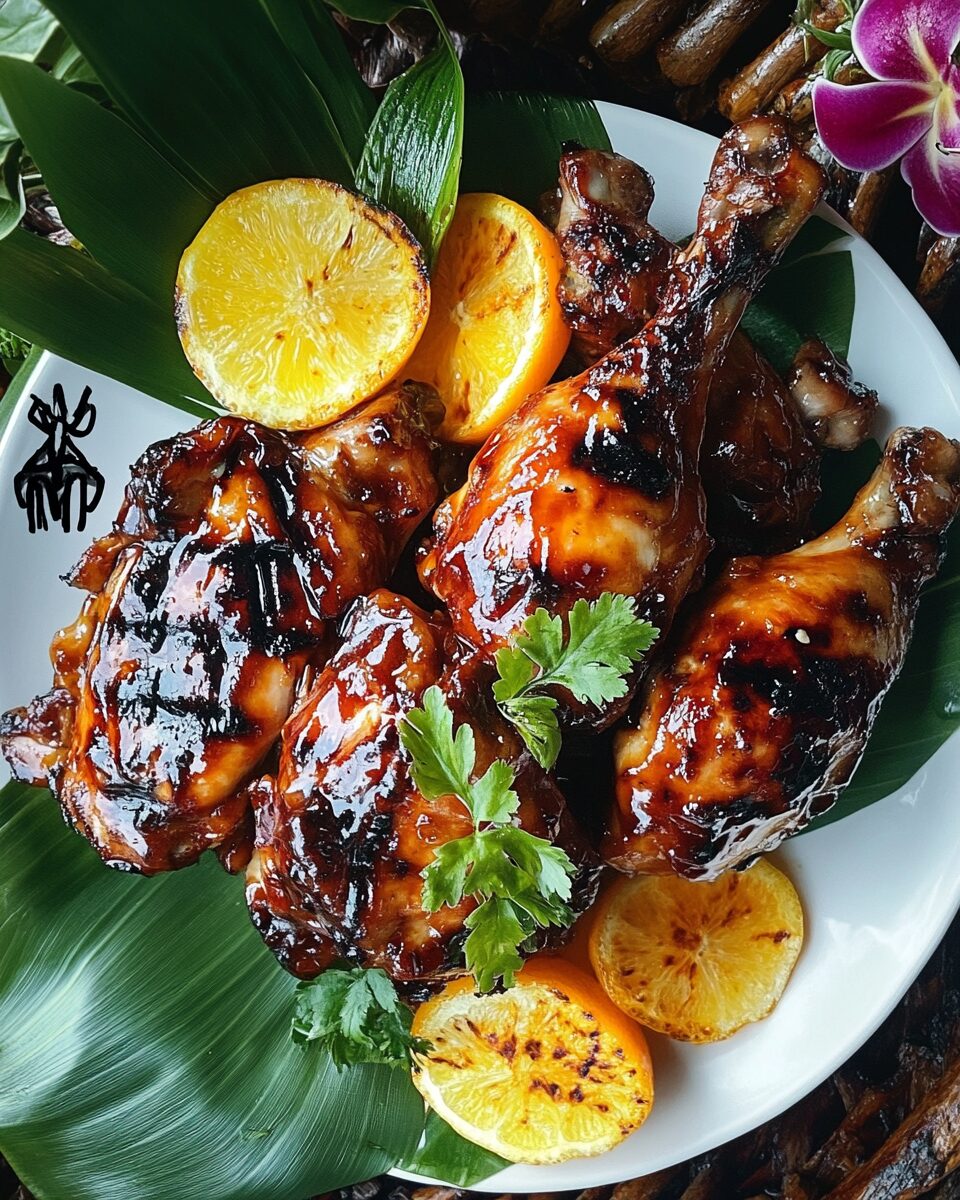The sweet and tangy combination of pineapple juice, soy sauce, and ginger creates an irresistible glaze that caramelizes beautifully on the grill, giving this Hawaiian Huli Huli Chicken its signature island flavor. It’s a dish that’s both mouthwatering and incredibly simple to prepare perfect for weeknight dinners or outdoor gatherings.
Whether you’re hosting a summer BBQ or just want to shake up your chicken routine, this recipe delivers big flavor with minimal effort. Serve it with steamed rice, a fresh salad, or grilled pineapple for a tropical twist that brings sunshine to your plate.
Full Recipe:
Ingredients:
-
4 boneless, skinless chicken thighs
-
1/2 cup soy sauce
-
1/2 cup brown sugar
-
1/4 cup ketchup
-
1/4 cup pineapple juice
-
1 tablespoon rice vinegar
-
2 cloves garlic, minced
-
1 teaspoon fresh ginger, grated
-
1 tablespoon sesame oil
-
1 tablespoon cornstarch
-
1 tablespoon water
-
2 tablespoons chopped green onions
-
Fresh pineapple slices (optional, for grilling)
Directions:
-
In a medium bowl, whisk together soy sauce, brown sugar, ketchup, pineapple juice, rice vinegar, garlic, ginger, and sesame oil.
-
Place the chicken thighs in a resealable plastic bag or shallow dish and pour the marinade over them. Marinate for at least 2 hours, preferably overnight.
-
Preheat your grill to medium heat.
-
Remove the chicken from the marinade and set aside the liquid.
-
Grill the chicken for 6-7 minutes per side or until the internal temperature reaches 165°F (75°C), basting occasionally with the reserved marinade.
-
While grilling, bring the reserved marinade to a boil in a small saucepan. In a small bowl, whisk together cornstarch and water and stir it into the boiling sauce to thicken. Simmer until glossy.
-
Brush the thickened glaze over the chicken during the final minutes of grilling.
-
Serve hot, garnished with chopped green onions and grilled pineapple if desired.
Prep Time: 10 minutes | Cooking Time: 15 minutes | Total Time: 25 minutes
Kcal: 295 kcal | Servings: 4 servings
Discovering Huli Huli Chicken: Hawaii’s Irresistible Grilled Treasure
If you’ve ever bitten into a perfectly grilled piece of chicken, rich with smoky char and glazed with a sticky-sweet tropical sauce, then you’ve experienced something close to Huli Huli Chicken a beloved Hawaiian classic that has made its way from roadside grills to food festivals, family gatherings, and now, home kitchens across the globe. This dish isn’t just about taste it’s a reflection of Hawaiian hospitality, tradition, and the irresistible pull of simple ingredients elevated by fire and time.
In this article, we’ll explore the origins, flavor profile, cultural significance, and cooking methods behind this island staple. Whether you’re a curious foodie or a home cook looking to bring some island flair to your dinner table, Huli Huli Chicken delivers a feast of flavor and history worth savoring.
A Brief History of Huli Huli Chicken
The story of Huli Huli Chicken begins in the 1950s, thanks to Ernest Morgado, a Hawaiian businessman who developed the dish during a fundraising barbecue for the Hawaiian Poultry Producers Cooperative Association. Using a soy sauce-based marinade influenced by his Japanese roots, Morgado grilled chicken between two racks and rotated it over a charcoal fire. Each time the racks were flipped, someone would shout “huli,” the Hawaiian word for “turn.” Thus, the name Huli Huli Chicken was born an ode to the rotation technique that ensures the meat is evenly grilled and richly flavored.
What began as a local favorite soon exploded into a statewide phenomenon. Morgado trademarked the name “Huli Huli,” and by the 1960s, roadside stands, beachside gatherings, and community events across Hawaii were serving up this sweet and savory grilled masterpiece. It became more than just a meal; it became a part of Hawaii’s culinary identity.
What Makes Huli Huli Chicken So Special?
At its core, Huli Huli Chicken is a marriage of two culinary traditions: Hawaiian barbecue and Asian-inspired marinades. The original marinade typically includes soy sauce, brown sugar, ginger, garlic, and pineapple juice, creating a harmony of salty, sweet, and umami flavors. Additional elements like ketchup, Worcestershire sauce, and sesame oil have been added over time to deepen the complexity.
The chicken most often bone-in thighs or whole chickens is marinated for several hours or overnight to absorb the full spectrum of flavors. It’s then grilled over an open flame, ideally over kiawe wood, Hawaii’s native mesquite, which imparts a subtle smoky aroma.
The frequent flipping of the chicken not only ensures even cooking but also allows the glaze to caramelize, forming a slightly sticky, golden crust that seals in moisture and creates a mouthwatering texture. This technique is key to the dish’s appeal it’s grilled, but not dry; sweet, but not cloying; rich, but still incredibly balanced.
Cultural Significance and Local Traditions
Huli Huli Chicken is more than a popular dish it’s part of Hawaii’s cultural and social fabric. Often served at fundraisers, family gatherings, school events, and food festivals, this dish represents the aloha spirit of sharing and community.
At these events, it’s common to see entire chickens skewered on massive grills, turned manually or with mechanical rotators, filling the air with the unmistakable scent of char and sweet marinade. The aroma alone is enough to draw a crowd, but it’s the sense of togetherness and tradition that keeps people coming back for more.
Huli Huli Chicken has also become a symbol of Hawaiian-style barbecue, distinct from mainland versions. It lacks the heavy smoke and dry rubs found in Southern BBQ traditions, favoring instead a lighter, sweeter, soy-based glaze. It reflects the fusion of Pacific Islander and Asian cuisines that define much of Hawaii’s food culture.
Tips for Cooking the Perfect Huli Huli Chicken at Home
You don’t have to be in Hawaii to enjoy authentic Huli Huli Chicken. With a few essential tips, you can recreate this tropical favorite in your own backyard.
1. Marinate Generously
The longer the chicken sits in the marinade, the deeper the flavor. Overnight marinating is ideal, allowing the acid from the pineapple juice to tenderize the meat while the other ingredients infuse it with bold, balanced flavor.
2. Grill Over Medium-High Heat
Charcoal grilling is the traditional method and delivers the best flavor. If you’re using a gas grill or grill pan, try adding wood chips for that extra smokiness. Avoid cooking over excessively high heat to prevent burning the sugars in the marinade.
3. Baste as You Grill
Reserve some marinade (or make a fresh batch for safety) to brush over the chicken as it cooks. This helps build layers of flavor and that signature sticky-sweet glaze.
4. Use Dark Meat for Juicier Results
Bone-in chicken thighs or drumsticks work best, as they remain juicy under high heat and are more forgiving if slightly overcooked.
Perfect Pairings and Serving Suggestions
Huli Huli Chicken shines brightest when served with complementary sides that enhance its tropical and savory notes. Here are a few serving ideas:
-
Steamed White Rice or Coconut Rice: A neutral base that absorbs the sauce beautifully.
-
Grilled Pineapple Slices: Their caramelized sweetness pairs perfectly with the glaze.
-
Macaroni Salad: A staple in Hawaiian plate lunches, this creamy side balances the dish’s bold flavors.
-
Fresh Green Salad with Ginger Dressing: Adds freshness and a hint of spice.
-
Coleslaw with a Vinegar-Based Dressing: The tang cuts through the richness of the chicken.
For drinks, think light and refreshing: a cold Hawaiian beer, iced green tea, or a tropical fruit smoothie can complete the meal.
Nutritional Benefits and Dietary Notes
While Huli Huli Chicken is known for its rich glaze, it can still be a relatively healthy dish, especially when prepared with lean cuts and served with fresh, whole-food sides. A typical serving made with skinless chicken thighs offers a good source of protein, iron, and B vitamins. Using lower-sodium soy sauce and minimal added sugar can reduce the sodium and calorie content while preserving the signature flavor.
For those following special diets:
-
Gluten-Free: Use tamari or a gluten-free soy sauce alternative.
-
Low-Sugar: Substitute brown sugar with a natural sweetener like honey or monk fruit syrup.
-
Low-Fat: Opt for chicken breasts instead of thighs.
Why You Should Try Huli Huli Chicken Today
There’s something universally appealing about food cooked over fire and when it’s basted with a sticky-sweet tropical marinade, you know you’re in for something special. Huli Huli Chicken is easy enough for a weeknight dinner, yet impressive enough for entertaining. Its unique blend of Asian and Polynesian influences makes it stand out in a sea of ordinary chicken dishes.
It’s also a recipe that invites experimentation. Add your own spin with extra spice, different marinades, or even try it with pork or tofu. However you make it, the heart of Huli Huli Chicken remains the same: a celebration of good food, shared with good company.
Conclusion:
Whether you’re hosting a summer barbecue, planning a luau-themed party, or just looking for something new to add to your weeknight rotation, Huli Huli Chicken is a recipe worth mastering. It’s more than just a meal it’s a tribute to Hawaiian flavors, a nod to culinary tradition, and a perfect example of how food can bring people together.
So fire up that grill, turn up some island tunes, and let the sweet smell of sizzling chicken transport you to the beaches of Hawaii. With just a few ingredients and a bit of aloha, Huli Huli Chicken might just become your new favorite dish.






